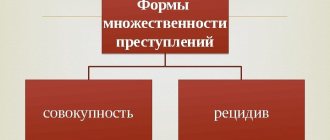Addition of punishments for a set of crimes is a fairly common judicial practice operating on the territory of the Russian Federation. This technique is applied to criminals who are accused of two or more illegal actions. For each specific crime, the culprit must suffer a well-deserved punishment.
This happens according to the following scheme: the degree of guilt and responsibility for each crime committed is determined. Following this, the final punishment is imposed by following the principles of addition or absorption. Let's look at how these regulations operate in reality.
What is a set of crimes called?
This term is usually understood as plurality, when a citizen simultaneously or sequentially commits several illegal actions falling under various articles of the Criminal Code .
This may include liability regulated by different parts of one article of the Criminal Code. The only caveat is that the accused has not been sentenced for any of the crimes charged. However, there are some peculiarities here. For example, theft of someone else's property using official authority and abuse of official position do not imply a combination of crimes. In fact, here abuse of power is a concomitant symptom of a more serious crime.
Plurality implies cases where each of the illegal actions is an independent type of crime committed. For example, the accused commits illegal acts while simultaneously fulfilling the elements of another completed crime. This may include a case where a criminal shoots a victim in the back, intending to take his life, but the bullet hits another person in the shoulder. The result is attempted murder and manslaughter.
These subtleties and nuances are set out in detail in Art. 69 of the Criminal Code of the Russian Federation, which regulates the following features:
- for crimes of minor and moderate gravity, the cumulative punishment is calculated by addition or absorption, but cannot exceed ½ of the term nominally permissible or assigned for the most dangerous crime committed;
- for crimes falling under the definition of grave/especially grave punitive measures are chosen based on the principles of partial/full addition, and the final verdict cannot exceed ½ of the punishment imposed for the most dangerous crime;
- it is allowed to add additional sanctions to the main punishments, while the final retribution does not exceed the maximum established period of imprisonment or other punitive measures;
Important! If a prisoner is accused of another crime committed before the trial of the main case, the decisive penalty is determined according to the above principles. In this case, the sentence already served will necessarily be taken into account.
What does judicial practice show under the article?
The practice under this article is extensive, since many criminals act under several articles at the same time.
Examples of cases:
- Citizen Zh. committed several crimes. First, he entered the neighbor’s home illegally, then tied him up and unlawfully deprived him of his freedom, then took away part of the property, thereby causing property damage. In addition, he hit the man on the head and he lost consciousness, causing minor injuries. The investigation arrested the criminal. Several unlawful acts were taken into account when sentencing. In total, Zh. received 5 years of arrest and a fine of 300 thousand rubles, including payment for moral and property damage and the cost of treatment of the victim.
- Citizen F., while intoxicated, beat and raped his pregnant wife, and then his 12-year-old child. As a result, both received multiple injuries. F. disappeared after the crime, but was found. When sentencing, the court took into account aggravating circumstances and the two crimes together. He received 15 years in prison.
- Citizen E. was engaged in prostitution and at the same time sold drugs to her clients. She was detained by a police officer during a planned operation. She was arrested and the case began to be investigated. As a result, for several crimes committed in total, she received 6 years in prison and compulsory labor.
What decisions are most often made under Article 69?
Defendants are often accused of multiple offenses. The greater the number of such episodes, the more dangerous the consequences for society. This circumstance necessitates the use of strict corrective measures. More often, the article makes guilty decisions, and more strictly than separately for each article.
What is the difference between a set of crimes and a sentence?
The law and amendments do not describe the concept of cumulative sentences. A conviction in this situation is used if the convicted person committed new dangerous actions after the appointment of corrective measures.
There are 3 types of aggregate sentences:
- combination with relapse;
- unification without relapse;
- combination with a set of crimes.
Consideration of acts as a whole does not affect the qualification of punishment. The totality of sentences covers the area of recidivism. The takeover rule is not allowed. Relapse is taken into account when choosing only the type of colony and is an aggravating factor.
Cumulative sentences also apply if the punishment is not carried out. The unfulfilled part includes: the full period of the suspended sentence, part of the period after parole, the time for deferring the execution of compulsory measures, the period of release due to illness. Situations are often considered when the court first applies a set of crimes, and then sentences.
The principle of adding punishments
This legal practice is regulated by Article 70, which determines punishment by adding to the sentences imposed. It looks like this:
- The remaining part of the previous punishment is partially/fully added to the last verdict;
- Punitive measures that do not imply detention do not exceed the maximum permissible amount;
- The terms of a multiple sentence implying detention do not exceed 30 years, the only exception: atrocities under Part 5 of Article 56 of the Criminal Code;
- Final punishment, implying the totality of always greater responsibility for the crime committed and the unserved part of the previous sentence;
- Additional sanctions are added in accordance with paragraphs of Article 69.
Download for viewing and printing:
Article 56 of the Criminal Code of the Russian Federation “Deprivation of liberty for a specified period”
Article 69 of the Criminal Code of the Russian Federation “Punishment for a set of crimes”
Article 70 of the Criminal Code of the Russian Federation “Punishment based on the totality of sentences”
Partial addition
This implies the fact that the term of the next most serious crime from the episodes considered during the trial is added to the punitive sanctions for the commission of the most dangerous crime committed.
Full addition
In this case, the terms for each unlawful act committed are sequentially summed up. For example, the accused is sentenced to a year of imprisonment for one crime, and to 6 months of correctional labor for another. When summing up the penalties and recalculating the penalties, this citizen will receive 14 months in prison. The principle applies here is that a mild punishment is expressed in a more severe form.
Ratio rules
Here you can refer to Article 71 of the Criminal Code of the Russian Federation, which predetermines the degree of responsibility for a set of crimes in the ratio of various punitive measures. According to these provisions, 1 day of imprisonment is equivalent to:
- 1 day of forced labor;
- 2 days of restriction of freedom of movement;
- 3 days of imposed restrictions on service or correctional labor;
- 8-hour mandatory work;
Important!
Monetary penalties, deprivation of titles and a ban on engaging in certain types of activities do not correlate with any means of deprivation of liberty and are expressed as an independent penalty measure. Download for viewing and printing: Article 71 of the Criminal Code of the Russian Federation “The procedure for determining the terms of punishment when adding sentences”
What is the difference between a complex crime and multiple crimes?
Author of the question: Zuev N. Created: 12/10/21
The difference between multiple crimes
from a single
complex crime
.
Multiple crimes,
unlike
single crimes, consist of two or more
crimes
.
Single crimes
can have
complex
content, reminiscent of a multiple
crime
due to several acts that form them.
Answered by: Shilov V. 12/11/21
Penalty credit
This procedure is regulated by Article 72 of the Criminal Code of the Russian Federation.
Here, the rules for counting the time spent in custody before a court decision on the final punishment for crimes committed are considered in detail. This is due to the fact that after arrest, the accused may spend some time in a temporary detention center while the investigation continues and legal proceedings are carried out. In this case, the court decision may not impose punitive measures in the form of imprisonment on the detainee. Download for viewing and printing: Article 72 of the Criminal Code of the Russian Federation “Calculation of sentence terms and offset of punishment”
Varieties
Types of offset of punishments are expressed in the following forms:
- applied as compensation for actual time spent in isolation from society;
- mitigating or canceling the imposed punishment.
In particular, when a person who was in custody before trial is charged with a fine, then by offsetting the penalties, the amount of payments can be reduced or the citizen will be completely released from the imposed penalty.
Basic provisions
These may include the following provisions:
- Mandatory service is calculated in hours, other penalties in months and years;
- It is permissible to calculate the terms in days, taking into account that 240 hours of compulsory work will be equal to a month of imprisonment, 2 months of limited freedom of movement, 3 months of restriction on service or correctional labor;
- The time of pre-trial detention is calculated in the following ratio: to the assigned imprisonment, arrest, detention in disbat, forced labor 1:1. Correctional work and restrictions on promotion - 1:3; when compulsory work is assigned, a day of imprisonment is equivalent to 8 hours.
In cases where the unlawful act was committed outside the country and the accused is held in custody in the territory of another state before the verdict is announced, the penalty credit is calculated in a ratio of 1:1.
Special
Here we can distinguish three main factors that can change the limit of the imposed punishment. In particular:
- increasing the lower limit of permissible sanctions, for example, in case of recidivism;
- reduction of penalties for active cooperation with investigative authorities;
- deviation from the limits of sanctions defined by a specific article of the Criminal Code if there are compelling reasons.
In addition, this includes cases when the previous sentence has not been fully served, but a citizen commits a new crime. Here the penalties are calculated according to the following scheme:
- Conditional sentence - the entire term is counted, with the exception of pre-trial detention;
- Parole - all unserved part;
- Deferred punishment is the entire portion that has been deferred.
What is the difference between multiple crimes and single crimes?
Author of the question: Ignatov N. Created: 12/15/21
Multiplicity of crimes
in
contrast
to
single crimes
, it consists of two or more
crimes
.
Single crimes
may have complex content, reminiscent of
a
multiple crime due to several acts that form them.
A continuing crime
is determined by the very construction of the norm (Articles 158, 159, 160 of the Criminal Code).
Answered by: Kazakova I. 12/15/21
Appointment in case of multiple acts
Taking into account the fact that it is assumed not only the combination of several verdicts, but also acts, the issue of this type of multiplicity of dangerous actions, such as the addition of crimes, should be separately considered. Practice brings the concepts under consideration together, which requires separate coordination of each option.
To connect several crimes in one criminal case, the fact that a person has not been involved as a suspect and the person has committed several acts at once will be required.
This procedure has two stages. The first is the appointment of a coercive measure for each individual crime. This need is due to the fact that various attacks can be committed jointly, up to particularly serious offenses, which makes the list of possible types of restrictions more disparate. Without specifying each individual act, it will be impossible to adjust the overall measure of influence in compliance with all established goals.
The second stage is the addition of the identified coercive means, using one of the possible methods:
- in case of fragmentation of restrictions, the absorption of a less strict measure by a more severe one due to the overall gravity of the offense;
- complete addition in case of possible mutual replacement of similar measures of influence;
- partial addition, in which some sanction remains in one type for a specific offense, and other types are added up, forming a total serving period.
The judge, through personal convictions and independent assessment of possible measures of influence, determines the method of adding restrictive measures.
Just as with the combination of decisions, the legislator determines restrictions in case of plurality. It is impossible to freely aggravate a compulsory remedy for the guilty person or, conversely, soften it. The main condition applies when imposing a sentence of imprisonment. Here the total term cannot exceed twenty-five years, unless we are talking about a life sentence.
In addition to the conditions outlined above, you should also remember the general principles of sentencing. If the act is not completed, then Article 66 of the code is applied, when the definition of accomplices is carried out - Article 33 of the Criminal Code of the Russian Federation, if a minor offender, then the limits of restrictions are taken into account, and so on. The only difference in the totality when compared with cases where individuals are tried for a single assault is the aggravating factor, which allows the punishment to be increased due to the increased danger of the actions of the perpetrator.






